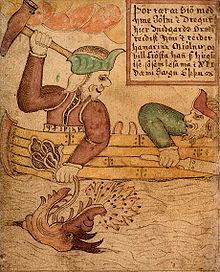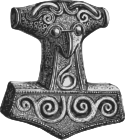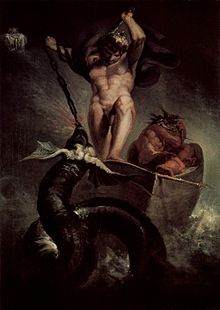- Jörmungandr
-
In Norse mythology, Jörmungandr (pronounced [ˈjœrmuŋɡandr']), mostly known as Jormungand, or Jörmungand (Old Norse: Jǫrmungandr), or Midgard Serpent (Old Norse: Midgarðsormr), or World Serpent, is a sea serpent, and the middle child of the giantess Angrboða and the god Loki. According to the Prose Edda, Odin took Loki's three children, Fenrisúlfr, Hel and Jörmungandr, and tossed Jörmungandr into the great ocean that encircles Midgard.[1] The serpent grew so large that he was able to surround the Earth and grasp his own tail.[1] When he lets go, the world will end. As a result, he received the name of the Midgard Serpent or World Serpent. Jörmungandr's arch-enemy is the god Thor.
Contents
Sources
The major sources for myths about Jörmungandr are the Prose Edda, Húsdrápa, Hymiskviða, and Völuspá. Less important sources include kennings in skaldic poetry. For example in Þórsdrápa, faðir lögseims, "father of the sea-thread", is used as a kenning for Loki. There are also image stones from ancient times depicting the fishing encounter.
Stories
There are three preserved myths detailing Thor's encounters with Jörmungandr:
Lifting the cat
 Thor goes fishing for the Midgard Serpent in this picture from an 18th century Icelandic manuscript.
Thor goes fishing for the Midgard Serpent in this picture from an 18th century Icelandic manuscript.
In one, Thor encounters the serpent, who is disguised as a colossal cat by the giant king Útgarða-Loki. As one of the tasks set by Útgarða-Loki, Thor must lift the cat; though he is unable to lift such a monstrous creature as Jörmungandr, he manages to lift it far enough that it lets go of the ground with one of its four feet.[2] When Jörmungandr is revealed by Útgarða-Loki, the lifting is counted as an impressive deed.[2]
Thor's fishing trip
Another encounter came when Thor went fishing with the giant Hymir. When Hymir refused to provide Thor with bait, Thor struck the head off Hymir's largest ox to use as such.[3] They rowed to a point where Hymir often sat and caught flat fish, where he drew up two whales. Thor demanded to go farther into the water, and did so despite Hymir's warnings.
Thor then prepared a strong line and a large hook, which Jörmungandr bit. Thor pulled the serpent from the water, whereupon the two faced one another, Jörmungandr dribbling poison and blood.[3] Hymir went pale with fear, and as Thor grabbed his hammer to kill the serpent, the giant cut the line, leaving the serpent to sink beneath the waves.[3]
This encounter with Thor seems to have been one of the most popular motifs in Norse art. Four picture stones that have been linked with the myth include the Altuna Runestone, Ardre VIII image stone, the Hørdum stone, and the Gosforth Cross.[4] A stone slab that may be a portion of a second cross at Gosforth also shows a fishing scene using an ox head.[5] Of these, the Ardre VIII stone is the most interesting, with a man entering a house where an ox is standing, and another scene showing two men using a spear to fish.[6] The image on this stone is dated as being from the 8th[4] or 9th century. If the stone is correctly interpreted as depicting this myth, it demonstrates that the myth was in a stable form for about 500 years.[6]
The final battle
The last meeting between the serpent and Thor is predicted to occur at Ragnarök, when Jörmungandr will come out of the ocean and poison the sky.[7] Thor will kill Jörmungandr and then walk nine paces before falling dead, having been poisoned by the serpent's venom.[7]
See also
Notes
References
- Fee, Christopher R.; Leeming, David A. (2001). Gods, Heroes, & Kings: The Battle for Mythic Britain. Oxford University Press. pp. 36. ISBN 0-19-513479-6. http://books.google.com/books?id=sFlLHEIuVlgC&printsec=frontcover&cad=0#v=onepage&q&f=false.
- Sørensen, Preben M.; Williams, Kirsten (transl.) (2002). "Þorr's Fishing Expedition (Hymiskviða)". In Acker, Paul; Larrington, Carolyne. The Poetic Edda: Essays on Old Norse Mythology. Routledge. pp. 119–138. ISBN 0-8153-1660-7. http://books.google.com/books?id=j4bufbA_UpQC&lpg=PP1&pg=PP1#v=onepage&q=&f=false.
- Sturluson, Snorri; Brodeur, Arthur G. (transl.) (2008). Prose Edda. Forgotten Books. http://books.google.com/books?id=709O-kMFUk0C&printsec=frontcover&cad=0#v=onepage&q&f=false.
Norse paganism Deities,
heroes,
and figuresOthersAsk and Embla · Dís (Norns · Valkyries) · Dwarf · Einherjar · Elves (Light elves · Dark elves) · Fenrir · Hel · Jörmungandr · Jötunn · Sigurd · Völundr · Vættir
Locations Asgard · Bifröst · Fólkvangr · Ginnungagap · Hel · Jötunheimr · Midgard · Múspellsheimr · Niflheim · Valhalla · Vígríðr · Wells (Mímisbrunnr · Hvergelmir · Urðarbrunnr) · YggdrasilEvents Sources Society See also Categories:- World-bearing animals
- Creatures in Norse mythology
- Legendary serpents
- Germanic legendary creatures
- Germanic mythology
- Scandinavian legendary creatures
- Thor
Wikimedia Foundation. 2010.


